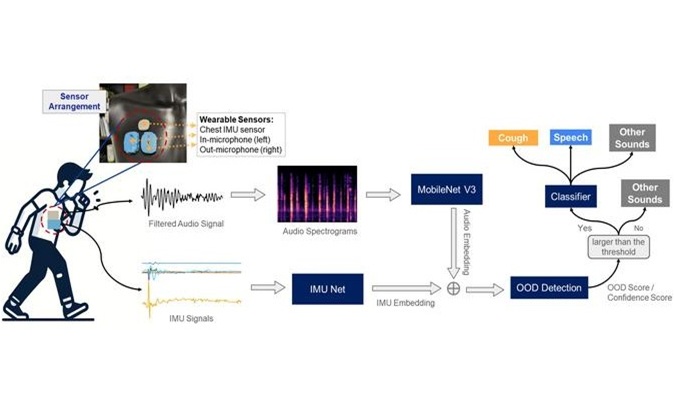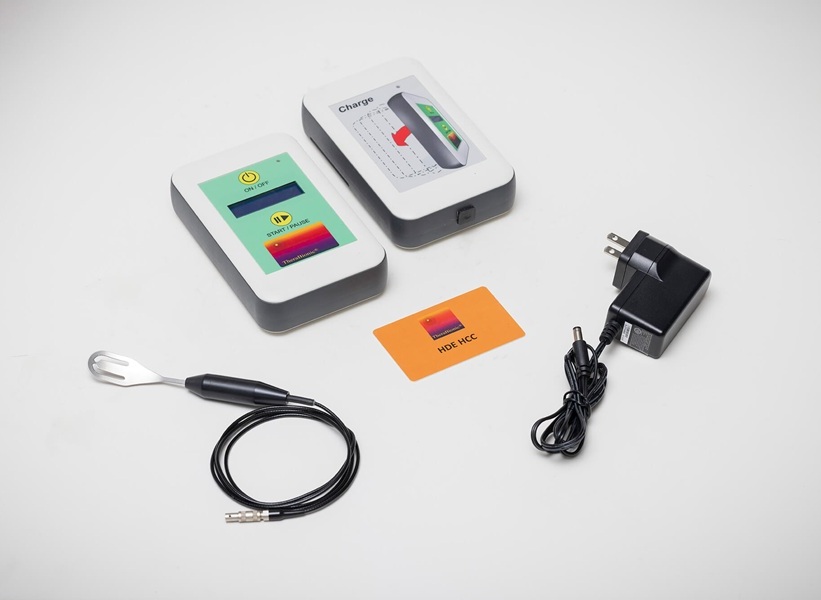Ultrasound During Active Labor Aids C-Section Prediction
|
By HospiMedica International staff writers Posted on 06 Mar 2016 |
A new study describes a model to predict vaginal or cesarean delivery based on maternal characteristics and the results of intrapartum ultrasound.
Researchers at St. Olavs Hospital (Trondheim, Norway), Addenbrooke’s Hospital (Cambridge, United Kingdom), and other institutions conducted a prospective observational study involving 122 nulliparous women in the first stage of labor, with the intent of developing a model to predict vaginal delivery using ultrasound. The model includes information on maternal age, body mass index (BMI), length of pregnancy, head-perineum distance, occiput posterior position, fetus rotation in the birth canal, and caput succedaneum (the swelling of the fetus' scalp).
Fetal head position was assessed with transabdominal ultrasound and cervical dilatation was assessed by digital examination; transperineal ultrasound was used to determine head-perineum distance and the presence of caput succedaneum. The women were divided into equal study and validation cohorts. A risk score for vaginal birth was developed, which was dichotomized into no (cesarean delivery) and yes (vaginal birth). The results showed that women with a derived dichotomized score above the median had greater than 10 times the odds of undergoing vaginal delivery. The study was published in the September 2015 issue of the American Journal of Obstetrics and Gynecology.
“Among first-time mothers, about 30% of deliveries go slowly. Labor can stop or slow down if the contractions are too bad, if the baby is big, if the birth canal is too narrow, or if the fetus is in the wrong position. It is important to determine the main reason,” said lead author Torbjorn Moe Eggebo, MD, chief physician at the National Center for Fetal Medicine at St. Olavs Hospital. “Some fetuses are called stargazers because they're lying face up in relation to the mother's womb when they come out. These births often take a long time, and more often end up as C-section deliveries.”
“Many women find it unpleasant to have a vaginal examination using fingers. Using ultrasound in the delivery room can reduce the number of vaginal examinations, and probably also the risk of infection during birth; and errors occur in at least 20% of clinical assessments compared to only 2% using ultrasound,” added Dr. Eggebo. “The women also get information on how the delivery is going, and they're able see images on the screen that show how the fetus is moving during contractions. It's easy to teach midwives and physicians to use these small ultrasound devices.”
The number of caesarean sections performed in different parts of the world varies greatly. In Brazil, for example, over 50% of all children are delivered by caesarean section, often without a thorough reason. In the United States, the frequency is 33%, while in Norway the frequency is 17%-18%. In outlying areas of many African countries, on the other hand, only one percent of babies come into the world through caesarean section, leading to maternal mortality. In Sierra Leone, a woman's lifetime risk of dying during pregnancy and childbirth is 15%.
Related Links:
St. Olavs Hospital
Addenbrooke’s Hospital
Researchers at St. Olavs Hospital (Trondheim, Norway), Addenbrooke’s Hospital (Cambridge, United Kingdom), and other institutions conducted a prospective observational study involving 122 nulliparous women in the first stage of labor, with the intent of developing a model to predict vaginal delivery using ultrasound. The model includes information on maternal age, body mass index (BMI), length of pregnancy, head-perineum distance, occiput posterior position, fetus rotation in the birth canal, and caput succedaneum (the swelling of the fetus' scalp).
Fetal head position was assessed with transabdominal ultrasound and cervical dilatation was assessed by digital examination; transperineal ultrasound was used to determine head-perineum distance and the presence of caput succedaneum. The women were divided into equal study and validation cohorts. A risk score for vaginal birth was developed, which was dichotomized into no (cesarean delivery) and yes (vaginal birth). The results showed that women with a derived dichotomized score above the median had greater than 10 times the odds of undergoing vaginal delivery. The study was published in the September 2015 issue of the American Journal of Obstetrics and Gynecology.
“Among first-time mothers, about 30% of deliveries go slowly. Labor can stop or slow down if the contractions are too bad, if the baby is big, if the birth canal is too narrow, or if the fetus is in the wrong position. It is important to determine the main reason,” said lead author Torbjorn Moe Eggebo, MD, chief physician at the National Center for Fetal Medicine at St. Olavs Hospital. “Some fetuses are called stargazers because they're lying face up in relation to the mother's womb when they come out. These births often take a long time, and more often end up as C-section deliveries.”
“Many women find it unpleasant to have a vaginal examination using fingers. Using ultrasound in the delivery room can reduce the number of vaginal examinations, and probably also the risk of infection during birth; and errors occur in at least 20% of clinical assessments compared to only 2% using ultrasound,” added Dr. Eggebo. “The women also get information on how the delivery is going, and they're able see images on the screen that show how the fetus is moving during contractions. It's easy to teach midwives and physicians to use these small ultrasound devices.”
The number of caesarean sections performed in different parts of the world varies greatly. In Brazil, for example, over 50% of all children are delivered by caesarean section, often without a thorough reason. In the United States, the frequency is 33%, while in Norway the frequency is 17%-18%. In outlying areas of many African countries, on the other hand, only one percent of babies come into the world through caesarean section, leading to maternal mortality. In Sierra Leone, a woman's lifetime risk of dying during pregnancy and childbirth is 15%.
Related Links:
St. Olavs Hospital
Addenbrooke’s Hospital
Latest Ultrasound News
Channels
Critical Care
view channel
Origami Robots to Deliver Medicine Less Invasively and More Effectively
Delivering medicine to ulcers or other internal sites often requires invasive procedures that can disrupt surrounding tissues and lengthen recovery times. Traditional magnetic actuators used in soft robotics... Read more
Improved Cough-Detection Technology Aids Health Monitoring
Coughing serves as an important biomarker for tracking a variety of conditions and can help monitor the progress of respiratory diseases or predict when someone’s asthma is being exacerbated.... Read moreSurgical Techniques
view channel
Novel Glue Prevents Complications After Breast Cancer Surgery
Seroma and prolonged lymphorrhea are among the most common complications following axillary lymphadenectomy in breast cancer patients. These postoperative issues can delay recovery and postpone the start... Read more
Breakthrough Brain Implant Enables Safer and More Precise Drug Delivery
Delivering medication directly to specific regions of the brain has long been a major challenge in treating neurological disorders. Current implants and infusion systems typically reach only one or two... Read morePatient Care
view channel
Revolutionary Automatic IV-Line Flushing Device to Enhance Infusion Care
More than 80% of in-hospital patients receive intravenous (IV) therapy. Every dose of IV medicine delivered in a small volume (<250 mL) infusion bag should be followed by subsequent flushing to ensure... Read more
VR Training Tool Combats Contamination of Portable Medical Equipment
Healthcare-associated infections (HAIs) impact one in every 31 patients, cause nearly 100,000 deaths each year, and cost USD 28.4 billion in direct medical expenses. Notably, up to 75% of these infections... Read more
Portable Biosensor Platform to Reduce Hospital-Acquired Infections
Approximately 4 million patients in the European Union acquire healthcare-associated infections (HAIs) or nosocomial infections each year, with around 37,000 deaths directly resulting from these infections,... Read moreFirst-Of-Its-Kind Portable Germicidal Light Technology Disinfects High-Touch Clinical Surfaces in Seconds
Reducing healthcare-acquired infections (HAIs) remains a pressing issue within global healthcare systems. In the United States alone, 1.7 million patients contract HAIs annually, leading to approximately... Read moreHealth IT
view channel
Printable Molecule-Selective Nanoparticles Enable Mass Production of Wearable Biosensors
The future of medicine is likely to focus on the personalization of healthcare—understanding exactly what an individual requires and delivering the appropriate combination of nutrients, metabolites, and... Read moreBusiness
view channel
Philips and Masimo Partner to Advance Patient Monitoring Measurement Technologies
Royal Philips (Amsterdam, Netherlands) and Masimo (Irvine, California, USA) have renewed their multi-year strategic collaboration, combining Philips’ expertise in patient monitoring with Masimo’s noninvasive... Read more
B. Braun Acquires Digital Microsurgery Company True Digital Surgery
The high-end microsurgery market in neurosurgery, spine, and ENT is undergoing a significant transformation. Traditional analog microscopes are giving way to digital exoscopes, which provide improved visualization,... Read more
CMEF 2025 to Promote Holistic and High-Quality Development of Medical and Health Industry
The 92nd China International Medical Equipment Fair (CMEF 2025) Autumn Exhibition is scheduled to be held from September 26 to 29 at the China Import and Export Fair Complex (Canton Fair Complex) in Guangzhou.... Read more















